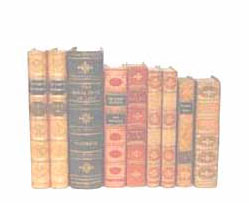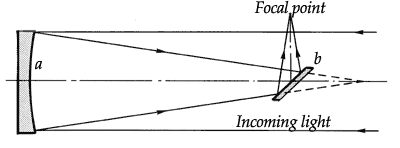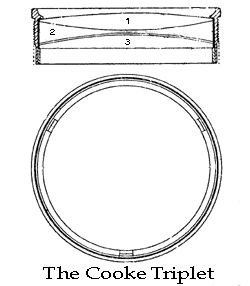
An early history of the telescope.
From 3500 B.C. until about 1900 A.D.
Contrary to popular opinion, Galileo did not invent the telescope. In 1609 the great Italian scientist turned his telescope toward the stars and saw the craters of the moon, sunspots, the four large moons of Jupiter, and the rings of Saturn. He saw the rings as "horns" since his telescope could not resolve the gap between the rings. His telescope provided limited magnification--only 30 power--and a narrow field of view; Galileo could see no more than a quarter of the moon's face at a time without moving his telescope. He was the first to publish his findings and risk the censure of the church and his colleagues. Following is a chronological history of the invention and development of the telescope.
- c. 3500 B.C. Phonenicians cooking on sand discover glass.
- 424 B.C. Aristophanes uses a glass sphere filled with water to start fires.
Lenses would not be used to study the stars for 2000 years.
- 14th century--convex lenses to correct farsightedness are developed.
- 15th century--concave lenses to correct nearsightedness are developed.
- 1608--In the Netherlands, Hans Lippershey discovers that holding two lenses up some distance apart
bring objects closer. He applies for a patent on his invention. This is the first documented
creation of a telescope. The idea is independently developed by Jacub Metius and
Sacharias Janssen. The patent to Lippershey is denied.
- 1609--Thomas Harriot (1560 – 1621) English astronomer, mathematician, ethnographer, and translator becomes the first person to make a drawing of the Moon through a telescope, on July 26, 1609, over four months before Galileo.
- 1609--Galileo, after simply hearing that the device was invented, builds several telescopes
of his own and turns them toward the heavens. He dared to publish his findings and was nearly burned at the stake for it.
There are other earlier recorded astronomical uses including viewing stars with Lippershey's own first telescope during its
demonstration and Thomas Harriot's views of the moon not long after.
- 1611--The term "telescope" is coined by Prince Frederick Sesi at a reception where
Galileo is demonstrating his instruments.
- 1611--Johannes Kepler switches from a concave eyepiece to a convex eyepiece. This not only
allowed a larger field of view, but it allowed for the projection of images (such as the sun)
onto a flat white screen. Although the images are inverted, Kepler demonstrates how a third
convex lens turns the images right-side-up again. The use of a third lens also degrades the images,
so this form of the telescope is not widely used. For terrestrial applications, particularly military
applications, the Galilean form of the telescope is the most widely used.
- Johannes Kepler studies the human eye and notices that the eye's lens is hyperboloidal. He suggests
the use of hyperboloidal lenses in the telescope. Spherical lenses are not very sharp because they
smear the rays of light over a very small area, a phenonomenon now known as spherical abberation.
- 1637--Rene Descartes demonstrated that speherical lenses cannot produce pinpoints of light. He studies
elliptical and hyperboloidal lenses and demonstrates that different combinations of hyperboloidal lenses
or elliptical lenses will produce a pinpoint of light and a sharper image. He has a Parisian optician produce
hyperboloidal lenses for a demonstration, but the lenses are a failure. Although the lenses corrected for spherical
abberation, they introduced another probelm--chromatic abberation, which made the problem worse. Chromatic abberation
means that different colors are focused at widely differing points, producing smeared images with halos around them.
- 1673--Johannus Hevelius realized that the longer the telescope was, the closer together
the different colored points of light would be at the focal point, yielding a sharper image. He constructs a telescope
140 feet long which probably gave very sharp images, but it was almost impossible to keep the two lenses aligned
because the supporting structure (usually a long tube) could not be made rigid enough.
- 1675--Christian Huygens suggests getting rid of the supporting structure and mounting the objective lens on the top
of a long pole. These were called "aerial telescopes" because they were open to the air. They were also much easier to
build and use. At the same time, Huygens developed a compound negative eyepiece using two air-spaced convex lenses.
This arrangement cancelled out some of the chromatic aberration that occurred in a single lens eyepiece.
- 1668--Robert Hooke demonstrates how to shorten the tube by using three or four perfectly flat mirrors to reflect the
image back and forth in a shorter tube. A 60-foot long telescope can be reduced to 12 feet long, greatly simplifying
support and stability.
- 1636--Marin Mersenne hit upon the idea of using two paraboloidal mirrors instead of lenses, but he never builds this
telescope, having been persuaded by Descartes that it could never work. The main advantage of using mirrors over
refracting lenses is that mirrors focus all points of the spectrum at the same point--no chromatic aberration!
- 1663--James Gregory designed a telescope using a concave primary mirror (slightly hyperboloid)
concave ellipsoidal secondary mirror. The first mirror gathers the light and reflects it onto the secondary. The secondary
mirror focuses the light back through a hole in the primary mirror. This is the basis for many telescopes made today, but
the opticians of his time were not able to produce mirrors of high enough quality to give good results.
- 1672--Cassegrain proposed a similar design using a convex secondary mirror that allowed the tube to be shortened even
more. More importantly, it cancelled abberations from the primary mirror and would have resulted in much sharper images,
had opticians been able to produce quality mirrors. It is interesting that Gregory, Cassegrain, and later Newton were
able to invent designs that were so far ahead of their time that no one could actually make one.
 1668--Newton produces the first successful reflecting telescope,
using a two-inch diameter concave spherical mirror, a flat, angled secondary mirror, and a convex eyepiece lens.
(See the drawing of Newton's telescope in this website.)
As is often the case in physics, the simplest solution is often the most practical one. The reflector telescope that Newton designed
opened the door to magnifying objects millions of times--far beyond what
could ever be obtained with a lens. There were problems with his mirror. It was made of copper and tin (called "speculum") and polished to a high degree
of reflectivity. It would tarnish quickly and need re-polishing at least twice a year. Newton was the most important thinker of his day, and he believed
that only mirrors would eliminate chromatic abberation and that it could never be done with lenses.
1668--Newton produces the first successful reflecting telescope,
using a two-inch diameter concave spherical mirror, a flat, angled secondary mirror, and a convex eyepiece lens.
(See the drawing of Newton's telescope in this website.)
As is often the case in physics, the simplest solution is often the most practical one. The reflector telescope that Newton designed
opened the door to magnifying objects millions of times--far beyond what
could ever be obtained with a lens. There were problems with his mirror. It was made of copper and tin (called "speculum") and polished to a high degree
of reflectivity. It would tarnish quickly and need re-polishing at least twice a year. Newton was the most important thinker of his day, and he believed
that only mirrors would eliminate chromatic abberation and that it could never be done with lenses.
The mirror telescopes of the day suffered from poor image quality. This was due to the use of a spherically ground primary mirror. Newton's mirror did not bring all rays of light to common focus. The shape of the mirror, if extended 360 degrees, would make a complete circle. Such a mirror is incapable of bringing central light beams to the same point of focus as those nearer the rim. It wasn't until 1730 when John Short corrected this problem (for on-axis light) by parabolizing the mirror. (See below).
- 1729--Chester Moor Hall develops an achromatic lens. Two pieces of glass with different indices of refraction can be combined
to produce a lens that tends to focus most colors at a very close (though not exact) point. Red and Green neatly blended at a point, but blue-violet still
missed that point by a small amount. The result was a much sharper image with violet halos around brighter objects. Refractors are suddenly popular again.
The images still show simple optical distortion around the edges, which mirrors developed around the same time did not.
- 1730--The Scottish Instrument maker James Short invents the first parabolic and elliptic,
distortionless mirror ideal for reflecting telescopes. Short accomplished this in a very practical manner: Since parallel rays nearer
the center of a spherical mirror overshoot the marginal rays coming from the edge of the mirror, why not just deepen the center to bring all
the rays of light to the same point of focus? James Short built over 1,360 telescopes. All had speculum mirrors. (It wasn't until the 1850's
that silver replaced speculum. SIlver had a longer lifespan, but still loses reflectivity quickly over time due to oxidation. By 1930 telescope
mirrors were being coated with aluminum, which is further overcoated with a clear coating.) Short was closely involved with the
Transit of Venus observations made throughout the world on 6th June 1761. His instruments travelled on the ship Endeavour with Captain Cook to
observe the Transit of Venus on 3rd June 1769. (See The Telescopes of Captain James Cook on this website.
- 1757--John Dolland improves upon the achromatic objective lens by placing a concave flint glass lens between two convex crown glass lenses. This
triplet uses the natural differences between the refractive indices of the two types of glass to cancel out chromatic aberration even more.
Some historians claim that the triplet was introduced in 1765 by Peter, son of John Dollond. Many excellent telescopes of this kind were made by him.
- 1789--Sir William Herschel constructs a forty foot long telescope with a four-foot diameter mirror. Reflector telescopes have become popular again
because they can be built with enormous mirrors, capable of gathering hundreds or even thousands of times more light than a refractor. Today we
call them "light buckets."

- 1893--H. Dennis Taylor, optical manager of T. Cooke & Sons of York, makers of astronomical telescopes, designed and patented the revolutionary, and
now famous, triplet design (British patent no. 1991). This lens eliminated the optical distortion at the outer edge of lenses.
The Cooke Triplet was a significant improvement of the Dolland triplet of more than a century earlier. The cooke triplet, seen at left,
is made of three different types of glass. No. 1 in the diagram is Schott's baryta light flint glass. No. 2 is Schott's boro-silicate flint glass,
and No. 3 is Schott's light silicate crown glass. The lenses are air-spaced, that is, not touching each other.
See American Astronomical Society Mitchell telescope
for an example of a Clark telescope using a Cooke Triplet.
Postscript: It wasn't until the mid-nineteenth century that opticians managed to get blue-violet to join red and green at the same point of focus. The use of flourite as an element in the doublet objectives of high-powered optical microscopes was copied by telescope makers. Three element telescope designs (triplets) with one element made of flourite now produce images that appear perfectly focused and free of all chromatic aberration to the human eye as well as to film and CCD's. Also see: The History of the Telescope & the Binocular An excellent collection of articles and images related to the history of the telescope by Peter Abraham.
| Home Page | Introduction | Before the Telescope | 17th Century Telescopes | 18th Century Telescopes | 19th Century Telescopes |
| 20th-century Telescopes | Captain James Cook | Spyglasses | Links | Bibliography | Fakes |